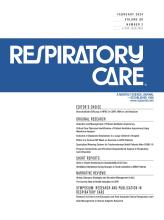Abstract
BACKGROUND: Dynamic hyperinflation (DH) is a major pathophysiology of COPD that is directly related to dyspnea and exercise intolerance. Positive expiratory pressure (PEP) might reduce DH and dyspnea during exercise, but at present, there is insufficient evidence to conclude whether it is beneficial for DH, dyspnea, and exercise capacity in COPD.
METHODS: A randomized crossover trial with concealed allocation was conducted in 37 moderate to very severe subjects with COPD (34 males, age 66.6 ± 7.4 y, FEV1% of predicted 56.3 ± 13.7). The experimental condition was conical-PEP breathing with a PEP of around 5 cm H2O during a spot marching exercise at a constant speed, inducing 71 ± 9% age-predicted maximum heart rate to symptom limit or 25 min. The control condition was usual breathing. Exercise endurance time and end-exercise symptoms were recorded. Inspiratory capacity (IC) was measured pre-exercise and immediately post exercise. Cardiopulmonary function and breathlessness were monitored throughout the test and after 10 min of recovery.
RESULTS: There were no complications or adverse effects during exercise with a conical-PEP mask. Conical-PEP showed longer exercise times than control (median 11.0 [interquartile range 7.7–17.0] min vs 8 [6.0–11.5] min, respectively, P < .001). Most stopped exercising because of breathlessness and leg fatigue. At the end of exercise, IC and breathlessness showed non-significant differences between the conditions, but breathlessness was significantly lower in conical-PEP (median 4 [1.5–5.0] than control 5 [3–6] on Borg scale at isotime for control [8 min]).
CONCLUSIONS: Breathing with a 5 cm H2O conical-PEP mask improved exercise time (median 27.1% [0.6–52.9]) in subjects with COPD. The improvement in exercise with the conical-PEP mask was associated with slower development of breathlessness, possibly due to delays in DH development.
- COPD
- PEP device
- endurance exercise
- dynamic hyperinflation
- dyspnea
- cardiopulmonary function
- randomized trial
- physiotherapy
Footnotes
- Correspondence: Chatchai Phimphasak PhD, School of Physical Therapy, Faculty of Associated Medical, Khon Kaen University, Khon Kaen, Thailand. E-mail: chatphi{at}kku.ac.th
↵† Deceased
The authors have disclosed no conflicts of interest.
A version of this paper was presented at the European Respiratory Society International Congress 2018, held September 15–19, 2018, in Paris, France. Eur Respir J 2018;52(Suppl 62):PA3636.
This study received joint funding from The Thailand Research Fund and Khon Kaen University in The Royal Golden Jubilee PhD Program (PHD/0082/2556).
- Copyright © 2024 by Daedalus Enterprises
Pay Per Article - You may access this article (from the computer you are currently using) for 1 day for US$30.00
Regain Access - You can regain access to a recent Pay per Article purchase if your access period has not yet expired.







